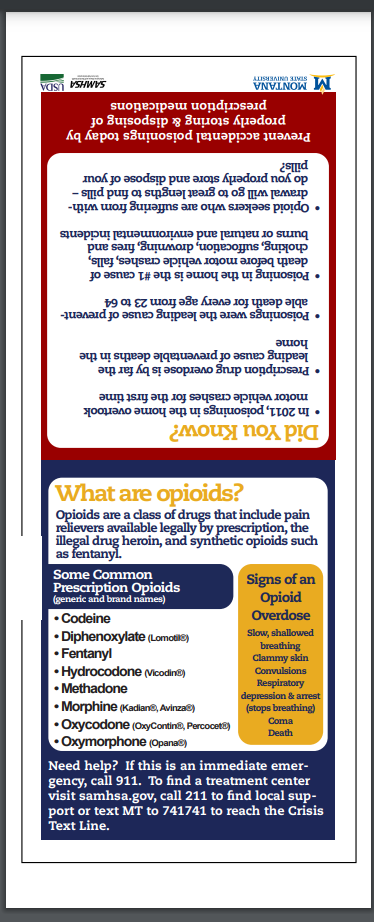MSU Opioid Misuse Table Tents

Download and print table tent #1
Download and print table tent #2
Download and print table tent #3
Each of the three listed table tents all have the following section called:
What Are Opioids?
Opioids are a class of drugs that include pain relievers available legally by prescription, the illegal drug heroin, and synthetic opioids such as fentanyl
Some Common Prescription Opioids (generic and brand names):
• Codeine
• Diphenoxylate (Lomotil®)
• Fentanyl
• Hydrocodone (Vicodin®)
• Methadone
• Morphine (Kadian®, Avinza®)
• Oxycodone (OxyContin®, Percocet®)
• Oxymorphone (Opana®)
Signs of an Opioid Overdose
Slow, shallowed breathing
Clammy skin
Convulsions
Respiratory depression & arrest (stops breathing)
Coma
Death
Need help? If this is an immediate emergency, call 911. To find a treatment center
visit samhsa.gov, call 211 to find local support or text MT to 741741 to reach the
Crisis
Text Line.
---------------------------------------------------------------------------------------------------------------------------------------------------------------------------
Table Tent #1:
Did You Know?
• In 2011, poisonings in the home overtook vehicle crashes for the first time
• Prescription drug overdose is by far the leading cause of preventable deaths in
the home
• Poisonings were the leading cause of preventable death for every age from 23 to
64
• Poisoning in the home is the #1 cause of death before motor vehicle crashes, falls,
choking, suffocation, drowning, fires and burns or natural and environmental incidents.
• Opioid seekers who are suffering from withdrawal will go to great lengths to find
pills –do you properly store and dispose of your pills?
Prevent accidental poisonings today by properly storing & disposing of prescription medications
Table Tent #2
Proper Disposal of Opioids
Find your nearest take back box and bring your unused medications to it, removing
them from your household and preventing them from getting into the wrong hands!
To Fnd a box nearest you, visit bit.ly/2MGXBLD
Disposal pouches are another safe way to dispose of medications. Simply drop your medications into the bag, add water, let the bag breathe for 30 seconds, then seal and throw away in the household trash. This process neutralizes the medications so chemicals aren’t going into waterways, and so people cannot abuse them. This is especially convenient for those who cannot drive.
For a full list of disposal options, including what is safe to flush, visit bit.ly/2M2Lh8I
Table Tent #3
Signs of Misuse
- Regularly taking an opioid in a way not intended by the doctor who prescribed it, including taking more than the prescribed dose or taking the drug for the way it makes a person feel
- Taking opioids "just in case," even when not in pain
- Mood changes, including excessive swings from elation to hostility
- Changes in sleep patterns
- Borrowing medication from other people or "losing" medications so that more prescriptions must be written
- Seeking the same prescription from multiple doctors, in order to have a "backup" supply
- Poor decision-making, including putting himself or herself and others in danger
